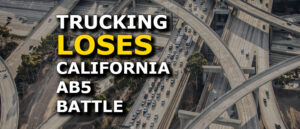How Fleets Can Easily Remove Crash Preventability Off CSA Scores
CNS can help with our Roadside & Incident Report Management service where a team of DOT Compliance Specialists will assess the Department of Transportation safety records
We are a team of DOT Compliance and Licensing Professionals helping trucking and transportation companies remain safe, compliant, and profitable.
CNS or Compliance Navigation Specialists is DOT Compliance company that assists trucking and transportation companies remain DOT Compliant. We are part of a network of companies, CNS Companies, specializing in services related to the transportation, manufacturing, construction, service, education and medical industries.

A full-scale DOT Compliance Program managing a long haul carrier’s safety, compliance, licensing and more.
Learn more >>>
A DOT Compliance Program that keeps motor carriers compliant with the 6 Basic DOT Regulations required of all carriers.
Learn more >>>
Our Short-Haul/Construction Program is a full-scale program designed for private carriers that do not haul for-hire.
Learn more >>>
Our most comprehensive DOT Compliance Program, operating as your company’s off-site Safety Director or assisting your current safety personnel.
Learn more >>>
Our Non-CDL Program is a full-scale program managing safety, compliance, licensing and more for moving companies, couriers, landscapers, or any company subject to DOT regulations and does not employ CDL drivers.
Learn more >>>
Our DOT Audit Services cover a number of different types of DOT Audits that new and existing carriers will be subject to.
Our DOT Driver Services help trucking companies and carriers to stay compliant as they grow and hire more drivers.
Our DOT Vehicle Services focus on ensuring your vehicles are compliant with DOT Regulations, which is just as important as your drivers.
Our DOT Services for Special Carriers focus on companies outside of the typical motor carrier, like HAZMAT, Passenger and Bus Carriers.
CNS is part of a group of companies that offer other necessary services for the trucking and transportation industry, such as Commercial Trucking Insurance, CDL Training, Online Training Course, and even Healthcare.
Our DOT Licensing Services will cover you whether you are an existing company or just starting a trucking company. Our DOT Licensing Specialists can help you get up and running and in days with your DOT number, MC Authority, EIN, UCR, IFTA, 2290 HVUT, Fuel Taxes and can even set you up to get your Commercial Driver's License (CDL) with CNS Driver Training Center.
Our DOT Licensing Specialists will help you with every aspect of starting a trucking company. All you need to do is choose a name for your trucking company.
You will need to ensure your DOT Number, MC Authority, Vehicle Registration, etc. is all set up properly when you start your trucking business.
Our Licensing Specialists can help with all aspects of filing and renewing licenses, fuel taxes, etc.
CNS is part of a group of companies that offer other necessary services for the trucking and transportation industry, such as Commercial Trucking Insurance, CDL Training, Online Training Course, and even Healthcare.
CNS can help with our Roadside & Incident Report Management service where a team of DOT Compliance Specialists will assess the Department of Transportation safety records
CNS or Compliance Navigation Specialists is DOT Compliance company that assists trucking and transportation companies remain DOT Compliant. We are part of a network of companies, CNS Companies, specializing in services related to the transportation, manufacturing, construction, service, education and medical industries.
CNS Companies is a network of companies specializing in services related to the transportation, manufacturing, construction, service, education and medical industries. Our DOT Compliance division is handled by Compliance Navigation Specialists, CNS Insurance handles Commercial Truck Insurance, CDL training is managed by the CNS Driver Training Center and healthcare is managed by CNS Occupational Medicine.
We are a team of DOT Compliance and Licensing Professionals helping trucking and transportation companies remain safe, compliant, and profitable.
CNS or Compliance Navigation Specialists is DOT Compliance company that assists trucking and transportation companies remain DOT Compliant. We are part of a network of companies, CNS Companies, specializing in services related to the transportation, manufacturing, construction, service, education and medical industries.

A full-scale DOT Compliance Program managing a long haul carrier’s safety, compliance, licensing and more.
Learn more >>>
A DOT Compliance Program that keeps motor carriers compliant with the 6 Basic DOT Regulations required of all carriers.
Learn more >>>
Our Short-Haul/Construction Program is a full-scale program designed for private carriers that do not haul for-hire.
Learn more >>>
Our most comprehensive DOT Compliance Program, operating as your company’s off-site Safety Director or assisting your current safety personnel.
Learn more >>>
Our Non-CDL Program is a full-scale program managing safety, compliance, licensing and more for moving companies, couriers, landscapers, or any company subject to DOT regulations and does not employ CDL drivers.
Learn more >>>
Our DOT Audit Services cover a number of different types of DOT Audits that new and existing carriers will be subject to.
Our DOT Driver Services help trucking companies and carriers to stay compliant as they grow and hire more drivers.
Our DOT Vehicle Services focus on ensuring your vehicles are compliant with DOT Regulations, which is just as important as your drivers.
Our DOT Services for Special Carriers focus on companies outside of the typical motor carrier, like HAZMAT, Passenger and Bus Carriers.
CNS is part of a group of companies that offer other necessary services for the trucking and transportation industry, such as Commercial Trucking Insurance, CDL Training, Online Training Course, and even Healthcare.
Our DOT Licensing Services will cover you whether you are an existing company or just starting a trucking company. Our DOT Licensing Specialists can help you get up and running and in days with your DOT number, MC Authority, EIN, UCR, IFTA, 2290 HVUT, Fuel Taxes and can even set you up to get your Commercial Driver's License (CDL) with CNS Driver Training Center.
Our DOT Licensing Specialists will help you with every aspect of starting a trucking company. All you need to do is choose a name for your trucking company.
You will need to ensure your DOT Number, MC Authority, Vehicle Registration, etc. is all set up properly when you start your trucking business.
Our Licensing Specialists can help with all aspects of filing and renewing licenses, fuel taxes, etc.
CNS is part of a group of companies that offer other necessary services for the trucking and transportation industry, such as Commercial Trucking Insurance, CDL Training, Online Training Course, and even Healthcare.
CNS can help with our Roadside & Incident Report Management service where a team of DOT Compliance Specialists will assess the Department of Transportation safety records
CNS or Compliance Navigation Specialists is DOT Compliance company that assists trucking and transportation companies remain DOT Compliant. We are part of a network of companies, CNS Companies, specializing in services related to the transportation, manufacturing, construction, service, education and medical industries.
CNS Companies is a network of companies specializing in services related to the transportation, manufacturing, construction, service, education and medical industries. Our DOT Compliance division is handled by Compliance Navigation Specialists, CNS Insurance handles Commercial Truck Insurance, CDL training is managed by the CNS Driver Training Center and healthcare is managed by CNS Occupational Medicine.

Examining problems is crucial for your fleet’s growth. Here’s how to do it.
Let’s get real for a second.
If you don’t examine your failures, nothing will change.
If you are honest with yourselves, you know there are management mistakes within your company or areas that could be managed better.
While this hasn’t led to DOT violations and fines, you know it is just a matter of time.
Luckily, it is human nature to want to be better, to grow, learn, and educate ourselves so we can improve.
That is why you are reading this article right now, but you just don’t know where to start.
Well, I am here to answer your questions.
Here are five steps to find issues in your fleet before the DOT does.
Our culture moves at a very fast pace, quick to move on and chase the next big thing.
Within the trucking industry, as a trucking professional, you might be an owner-operator hunting for the next best load and squeezing out as much drive time as possible.
Or you might be a safety manager trying to balance hiring, driver files, safety scores, driver problems, drug testing, ELD data, and more.
When was the last time you paused and allowed yourself to just think – without the anxiety and stress of the job?
If you are reading this right now, take a deep breath and start reflecting on what is working and not working.
Why are certain processes broken? Is there a better way? Why was your last project such a success? These are just a few questions that you can start asking yourself.
For example, when was the last time you thought about the company’s drug testing program, policies, and document retention requirements?
Did you know that one of the most common mistakes carriers make is not having important drug test history and medical card on file?
Each new medical exam certificate must be placed into the DQ file and kept there for at least three years, to show that the driver was medically qualified to drive at all times.
Similarly, important drug testing history and alcohol test results must be saved in the DQ File for at least one year.
Are you keeping up with your Drug Testing Program? Are you DOT Compliant?
No matter what situation you are facing in life right now, whether it be to better yourself by talking with a counselor or improving your company by talking to a mentor or consultant, the first step is always honesty.
As you reflect on what is and is not working with your job duties or across your entire fleet, write down:
While this may hurt your pride a bit, I bet it felt good to write these things down and get them off your chest.
One of the most common tasks carriers hate is analyzing ELD telematic data. Isn’t it good enough to just meet the requirements by having an ELD? You might think so, but insurance providers disagree.
Insurance providers love this data, but only if you are proactively reviewing and improving your fleet with the data.
The best-practice telematics data management plan will measure the data over time to show trends and measure results. This is as simple as a Driver Scorecard for your fleet.
If you have taken the time to reflect and are being honest with your list of pain points, the next step is to analyze why.
This is where you must ask the right questions.
Be sure to take the time to think about each scenario, each task, and each issue. Continue being honest with yourself on why something is broken.
The more you dig, continue asking more questions and don’t forget to write them down.
Let’s use the ELD telematic data example again. Why is the tool so under-utilized?
Fleets are often spread out in regional or national operations with high driver turnover rates, so it can be hard for managers or drivers to be up to speed on all ELD logs and data coming in.
Since ELDs are a relatively new requirement, the initial goal was to just meet the requirement and forget about it.
But a fleet’s back-office management have been given an opportunity to better improve their vehicles and driver’s safety by looking at where drivers are making common mistakes and proactively training them before they make a bigger mistake.
As you dive down the rabbit hole, you can start researching answers to your questions or issues.
When it comes to fleet safety management, we recently wrote a series of article about the importance of DOT audits.
Why is research so important? Because the regulations can get complicated.
For example, one of our most popular articles is about when it is okay to have multiple DOT numbers for a company.
Maybe you are looking to acquire or merge with another company. Maybe your fleet’s safety history is horrible, and you want to start over under a new DOT number. Are you making a big mistake?
Be sure to use our article search tool on the top of each blog post to dive deeper into your research.
In your research, you may have found that accuracy, organization, and diligence are crucial to keeping your safety program in order and ready for an audit at a moment’s notice.
If you don’t have a close mentor to help you, be sure to reach out to our DOT experts with a simple phone call, email, or you can even have a live chat with us online.
If you are looking to hire someone to help you manage your tasks, hire CNS.
Our safety management programs are perfect for combining multiple services and focuses on Proactive Safety Management (PSM), a mindset that will ensure your fleet’s safety and compliance is always in order and ahead of the FMCSA.
Our PSM Motor Carrier Program includes:

CNS can help with our Roadside & Incident Report Management service where a team of DOT Compliance Specialists will assess the Department of Transportation safety records

Do you travel in or through British Columbia, Canada? There is now a speed limiter requirement affecting most heavy trucks, as of Friday April 5,

If your lights aren’t on at night, but they work, that’s no longer an OOS violation, though it’s still a violation of state laws to

California’s AB5 legal battles, that cover an estimated 70,000 owner-operators, lose another chance to block the rule. The AB5 law makes it more difficult for
Our DOT Compliance Programs ensure it is your top priority and keeps your business running.
Receive the latest transportation and trucking industry information about FMCSA and DOT Audits, Regulations, etc.

CNS can help with our Roadside & Incident Report Management service where a team of DOT Compliance Specialists will assess the Department of Transportation safety records

Do you travel in or through British Columbia, Canada? There is now a speed limiter requirement affecting most heavy trucks, as of Friday April 5,

If your lights aren’t on at night, but they work, that’s no longer an OOS violation, though it’s still a violation of state laws to
Join our monthly newsletter and stay up-to-date on trucking industry news and receive important compliance and licensing tips.
Join our monthly newsletter and stay up-to-date on trucking industry news and receive important compliance and licensing tips.